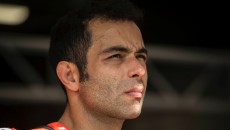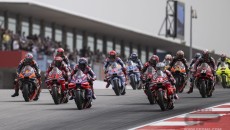This year's Moto2 has been somewhat revolutionised. The Honda four-cylinder is no more and now it's all about the Triumph three, an engine with a very different character, but also more modern and powerful than its predecessor. Initial results have been encouraging, with a top speed of more than 300 km/h having been set at Mugello (with Nicolò Bulega), not bad for what is essentially a production engine.
The Brits may therefore be causing their predecessors some regret, though at the time of the Triumph announcement there were those who turned their noses up. Without taking anything away from the Hinkley-based firm, it had been a long time since it had races and there were more doubts than certainties.
“Triumph was selected at the end of what was essentially a process of elimination" reveals Trevor Morris, technical director at ExternPro, the company charged with preparing and maintaining the British three-cylinders, and the Honda engines before that. He tells us something of the behind the scenes in the Moto2 championship.
"The Triumph engine had all the characteristics we were looking for"
“We wanted a production engine, because if we'd raced with a prototype, the costs would have been at least 10 times higher. The DNA of Moto2 lies in giving all teams the same chance, with contained costs”.
So they looked at what was available on the market.
“Going for a Japanese inline 4 would have been like continuing with Honda, it would have brought nothing new while we wanted precisely something new - continues Trevor - The engine also needed to satisfy certain requirements, weighing less than 50 Kg, offering more than 130 HP, there was basically a long list and the Triumph engine satisfied them all. I think it's a great opportunity for them to get back into races without going up against the giants that have gained great experience in recent years”.
The decision came down to the road-derived 765, which underwent just a few, important updates.
“The biggest difference between the standard engine and the one we're using in Moto2 is the alternator, much smaller because the electrical system is simplified on a race bike - explains Morris -The gearbox has a longer first and second, then there are some small details that differ, like the chain drive. Nothing major, for example we use standard pistons and camshafts. The most important thing is checking all of the engine parts to ensure only minimal differences. This is to ensure that all the engines have the same power, quality control is fundamental”.
"The three-cylinder has 140 HP and has to cover 1500 kilometres flat out"
The Triumph three-cylinder used in Moto2 achieves 140 HP and 14,000 rpm, while the road version peaks at 12,700. Performance is important, but so is reliability.
“Each team receives a new engine every 3 races, so each unit has to cover roughly 1500 kilometres - says Trevor - Engines are randomly assigned, on Thursday morning at 10.30 all the crew chiefs come in and take a number that relates to an engine. In this way, we're sure there is no favouritism”.
 Of course, they need to be sure that the differences between one engine and another are minimal. At ExternPro (based in Alcaniz, home to the Aragon circuit) three mechanics assemble the engines, while a technician tests them on the bench.
Of course, they need to be sure that the differences between one engine and another are minimal. At ExternPro (based in Alcaniz, home to the Aragon circuit) three mechanics assemble the engines, while a technician tests them on the bench.
“The difference in terms of power between the 'best' and 'worst' engine is around 1%, so less than 1.5 horsepower” the technical director confirms with pride.
It takes extreme precision to achieve this.
“After three races ‘we reconstruct' the engines, opening them and replacing certain parts - explains Trevor - During the first service, roughly 65/70% of parts are changed, then more during the second service. This is the same work method we used with the Honda engines, some parts might last longer than others bt there's no point taking any risks”.
Also because a failure could ruin a rider's race. For this reason, the ExternPro technicians seek to prevent problems rather than solve them.
“In case there is a failure, we have at least 12 spare engines at each race. We collate data from all the teams after every session to prevent any problems and we can intervene immediately if there is a failure."
There have been no problems up until now and riders seem happy. Many think the Moto2 is now more similar to the MotoGP.
“On the one hand, that's down to the engine - comments Morris - Because the Honda 4-cylinder was almost like a 2-stroke in terms of its characteristics. Then there's the electronics”.
"Electronics? It's the rider's right wrist that makes the difference"
 Which are entrusted to Magneti Marelli.
Which are entrusted to Magneti Marelli.
“The Moto2 ECU is basically a simplified version of those of MotoGP, for reasons relating to cost. The MotoGP ECU has two processors, the Moto2 only one, but it has the potential to do what it big sister does”.
The aim though is to limit intervention.
"We want to avoid introducing traction control, because it's the rider that needs to make the difference in Moto2, not the technology, the important thing should be the rider's right wrist - underlines Morris - Electronics makes it more interesting as teams work to find the best set-up but we don't want them to become dependent on it. They can currently choose between 20 mappings with different engine brake and torque characteristics and they can change them for each gear, so they already have a lot of options. Riders and teams are still learning how to exploit this, and when they do you'll see the times tumble”.
We can't wait.









